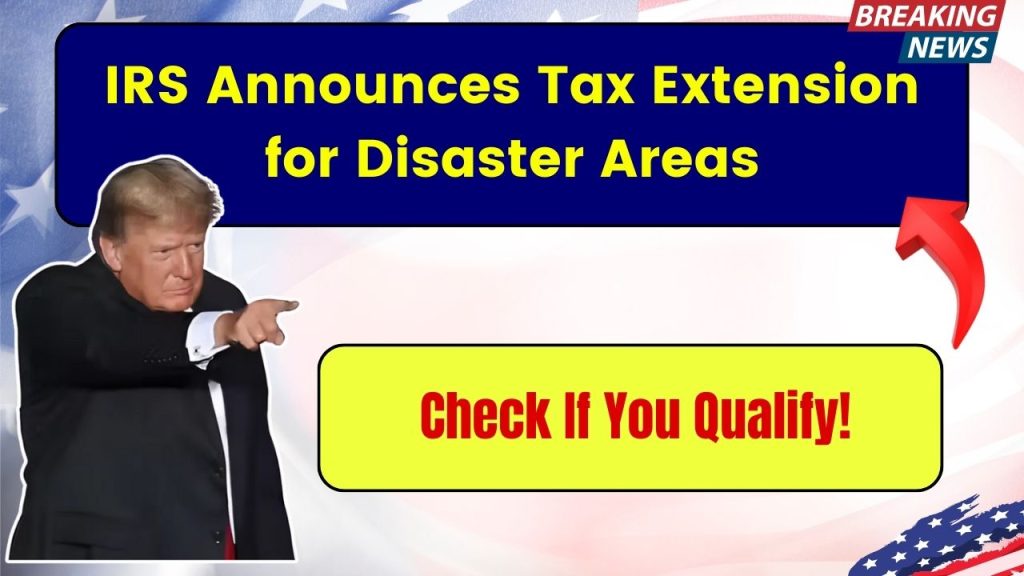IRS Announces Tax Extension for Disaster Areas: Disasters can wreak havoc not only on homes and communities but also on financial stability. Recognizing the hardships caused by natural calamities, the Internal Revenue Service (IRS) has announced tax extensions for individuals and businesses affected by federally declared disaster areas. This relief provides extended deadlines for filing tax returns and making payments, helping taxpayers recover without the added stress of tax deadlines looming over them.
To help you determine if you qualify and how to take advantage of these tax extensions, we’ve compiled a detailed guide with key insights, eligibility criteria, and step-by-step instructions.

IRS Announces Tax Extension for Disaster Areas
| Key Information | Details |
|---|---|
| Who Qualifies? | Residents, businesses, and relief workers in federally declared disaster areas |
| Relief Offered | Extended tax filing deadlines, penalty relief, casualty loss deductions, and tax record reconstruction assistance |
| Current Deadlines | Varies by disaster; some are extended up to October 15, 2025 |
| Official IRS Website | IRS Disaster Relief Page |
| How to Claim? | Extensions are automatic for affected areas; additional claims can be made via IRS Form 4684 |
If you live in an area affected by natural disasters, the IRS provides crucial tax relief, offering extra time to file and potential deductions for financial losses. By staying informed and taking proactive steps, you can reduce financial stress and focus on recovery.
For up-to-date details, always refer to the official IRS Disaster Assistance Page or contact the IRS directly.
Understanding IRS Tax Relief for Disaster Areas
When disaster strikes, the IRS often automatically extends tax deadlines for affected individuals and businesses. These extensions allow taxpayers to focus on recovery rather than worrying about tax deadlines.
What Does This Extension Cover?
- Extended Filing Deadlines – The IRS provides extra time to file income, business, and payroll tax returns.
- Penalty and Interest Relief – Late filing and payment penalties may be waived.
- Casualty Loss Deductions – You can deduct disaster-related losses on your tax return for the year of the disaster or the previous year.
- Reconstruction Assistance – If your financial records were lost or destroyed, the IRS offers guidance on reconstructing tax records.
- Expedited Refunds – Taxpayers can amend previous returns to receive refunds sooner.
- Filing Extensions for Non-Profit Organizations – Nonprofits in affected areas may qualify for additional relief.
Who Qualifies for Disaster Tax Relief?
You may be eligible for an IRS tax extension if:
- You live or operate a business in a federally declared disaster area.
- You are a relief worker assisting in a designated disaster area.
- Your tax records were lost due to the disaster, even if you don’t live in the affected area.
- You were injured or displaced due to the disaster.
- You have a business that suffered property damage and financial losses due to the disaster.
How to Check If Your Area is Covered
To determine if your area qualifies for tax relief:
- Visit the FEMA Disaster Declarations Page.
- Check the IRS Disaster Relief Updates here.
- Contact the IRS Disaster Hotline at 866-562-5227 for assistance.
How to Claim Your Tax Extension
Step 1: Confirm Your Eligibility
- Check if your address is in a federally declared disaster area.
- Verify the new extended deadline applicable to your situation.
Step 2: File Your Taxes by the Extended Deadline
- If you are eligible, your deadline is automatically extended.
- No need to file a request for an extension unless additional circumstances require one.
- File using IRS Free File or authorized e-file providers.
Step 3: Claim Casualty Loss Deductions
- If you suffered financial losses, you can claim a deduction using IRS Form 4684 (Casualties and Thefts).
- You have the option to apply the loss to your previous year’s return to get a faster refund.
- Ensure you keep proper documentation, including receipts and insurance claims.
Step 4: Seek Assistance for Lost or Destroyed Records
- If disaster-related damage caused loss of tax records, the IRS provides guidance on reconstructing them for free.
- Visit IRS.gov for more details.
- Request copies of past tax returns using Form 4506.
Step 5: Contact the IRS for Additional Assistance
- If you need further guidance, call the IRS disaster assistance line at 866-562-5227.
- Consider consulting a tax professional if your situation is complex.
2025 Tax Help at Risk for Seniors and Disabled People – Check the IRS Warning Now!
Tax Saving Section 80C: This is How You Can Save Your Tax, Full Guide with Examples & Steps
Giving Cash to Your Wife Can Get You an Income Tax Notice! Know These Rules to Stay Safe
FAQs About IRS Announces Tax Extension for Disaster Areas
1. Do I need to apply for a tax extension?
No, if you are in a federally declared disaster area, the extension is automatically granted.
2. Can I claim disaster losses even if my area is not listed?
Yes, but you’ll need to provide documentation and file IRS Form 4684 to request a loss deduction.
3. What happens if I still owe taxes?
The deadline to pay taxes is also extended, but interest may apply if you don’t pay by the new due date.
4. How do I find out my new deadline?
Check the IRS disaster relief page for the latest updates: IRS Disaster Relief.
5. Will the extension apply to state taxes?
State tax relief varies. Check with your state’s tax agency to confirm.
6. Can businesses claim additional deductions?
Yes, businesses affected by disasters may qualify for deductions on repair costs, property losses, and emergency-related expenses.
7. What if I need more time beyond the extension?
You can request an additional extension using IRS Form 4868, but you may need to pay estimated taxes by the new deadline.











